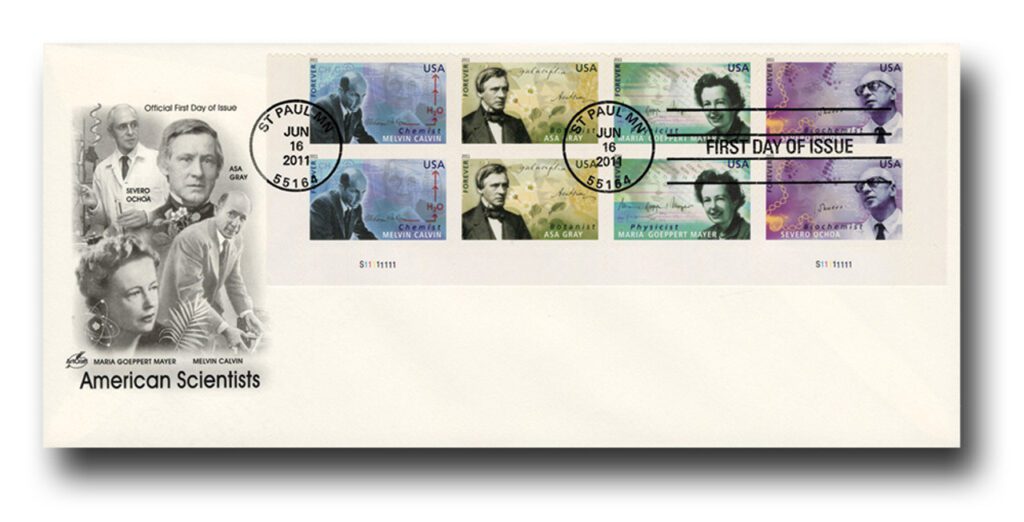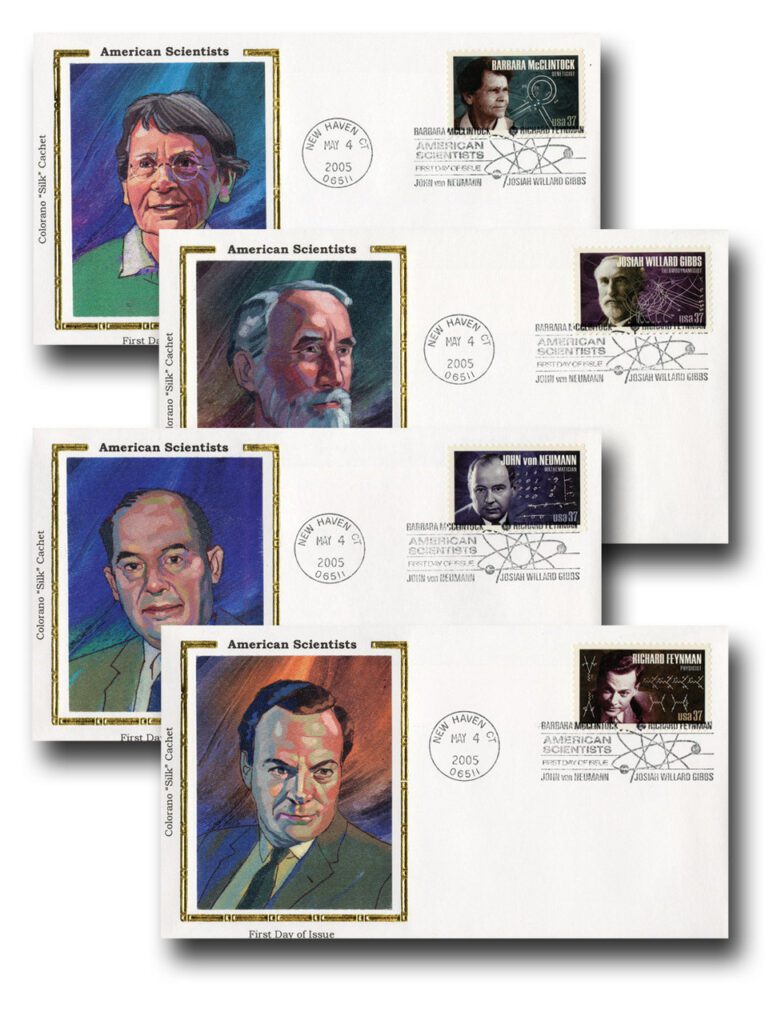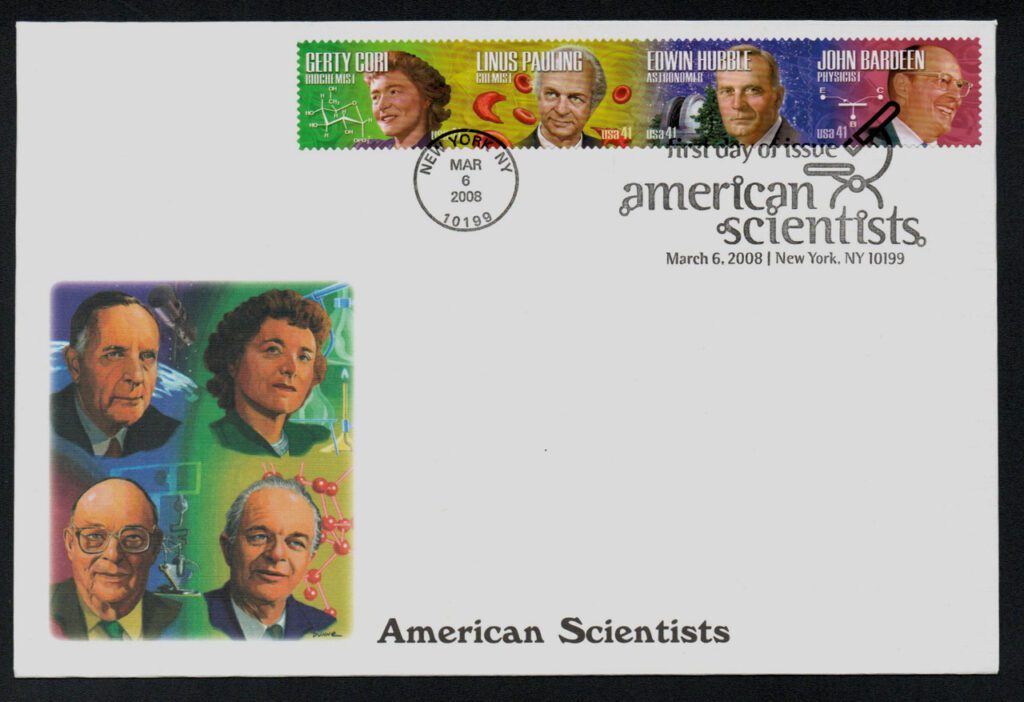On May 4, 2005, the USPS issued the first set of stamps in the American Scientists Series.
For several years, the USPS had received requests for stamps honoring various scientists. In 2005, they combined those ideas to create the American Scientists Series.
The first stamps were issued on May 4, 2005, at Yale University in New Haven, Connecticut, where Josiah Willard Gibbs had worked as a teacher. The First Day Ceremony included a speech from John Marburger, the scientific advisor to the president as well as the president of Yale University. Relatives of the scientists honored on the stamps were also present.
About the stamps, a USPS spokesperson said, “These are some of the greatest scientists of our time; their pioneering discoveries still influence our lives today.” Artist Victor Stabin designed all the stamps. He used a portrait of each scientist paired with drawings representing their major contributions to the world of science. He consulted with experts to ensure the science was correct.
After World War II, John von Neumann worked to develop large scale, high-speed electronic computers with stored programs. His design of the IAS computer – the von Neumann Architecture – became the model for most of its successors. Richard Feynman received the 1965 Nobel Prize in Physics. He invented the Feynman diagrams which depict arrows and squiggles to represent particle activity.
Barbara McClintock found that color changes in successive generations of maize were turned on or off by genetic “switches.” Moreover, these switches could move from one part of a chromosome to another. Her discovery was crucial to later genetic research. In the age of steam, Josiah Gibbs formulated the laws of thermodynamics – the relationship between heat and other forms of energy. His rules had applications to chemistry, manufacturing, and engineering.
The second installment in the American Scientists Series was issued on March 6, 2008, at Madison Square Garden, in New York City. A USPS representative said, “We are here to honor four extraordinary individuals who pushed back the frontiers of knowledge on behalf of all of mankind.” Family members of each of the scientists were present for the first-day ceremony and were all excited to see them honored on stamps.
Gerti Cori was the first female to earn a Nobel Prize for Physiology/Medicine in 1947. Working with her husband, Cori discovered how carbohydrates are metabolized in the body. The Cori Crater on the Moon was named for her. Linus Pauling is considered by most to be the father of molecular biology. He earned two Nobel Prizes, one for chemistry in 1954 and one for Peace in 1962. In 1973, Pauling co-founded the Linus Pauling Institute.
Astronomer Edwin Hubble forever changed the way we see our world. Before Hubble, it was thought that our Milky Way galaxy was the entire universe. Hubble’s research showed there are galaxies beyond our own. In 1990, the Hubble telescope was named after the distinguished astronomer. John Bardeen’s development of the transistor has made possible the creation of almost every other modern electronic device from telephones to missiles. He earned Nobel Prizes in 1956 and 1972 for his world-changing contributions.
The third installment in the American Scientists Series was issued on June 16, 2011, at the Science Museum of Minnesota, in St. Paul, Minnesota. In speaking about the stamps, the USPS said, “In this small way, we have created a lasting tribute to four extraordinary scientists, and as we share their legacy with Americans everywhere, it is our fervent hope that these stamps also will help to light the spark of science in young minds everywhere.”
The stamps honored Melvin Calvin, Asa Gray, Maria Goeppert Mayer, and Severo Ochoa. Three of them won the Nobel Prize in their respective fields. The fourth, Gray, lived in the 19th century, before the Nobel was established, but he enjoyed international renown for his work in botany. His books are still used today.

With tremendous dedication, these scientists opened doors for others to follow. Their persistence unlocked secrets of the workings of the world: from Calvin’s understanding of plants and energy to Goeppert Mayer’s investigation of atomic particles. Gray’s manuals detailing plants are still relevant more than 160 years later, and Ochoa’s research into the building blocks of life marked a critical advance.
| FREE printable This Day in History album pages Download a PDF of today’s article. Get a binder or other supplies to create your This Day in History album. |
Discover what else happened on This Day in History.






Thanks Mystic. I will read more about these scientists and their contribution to mankind.
Thank you Mystic for your great story about famous scientists!